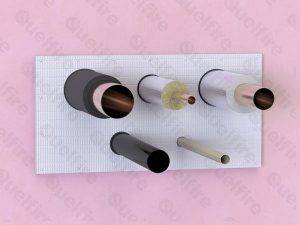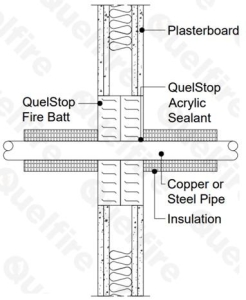How should metal pipes be insulated and firestopped? Tested Detail Queries

Pipes and services require insulation to limit heat transfer and provide a vapour barrier against moisture which, ultimately, improves the thermal efficiency of the building. Examples would include chilled water, air conditioning pipes, or hot water and heating pipes.
When it comes to insulation, there are various types available for use around copper and steel pipes and different installation methods.
Traditionally*, lagging has been cut back from around the metal pipe at the point of penetration and fire batt and acrylic sealant was used to seal directly around the non-combustible metal pipe.
Local interrupted insulation (where the insulation stops each side of the penetration seal at a minimum distance of 300-500mm from the face of the seal) would then be positioned on either side of the fire batt, as shown typically below:

*Other traditional methods include:
- Continuous interrupted (C/I): The insulation stops on either side of the penetration seal but continues throughout the building.
- Local sustained (L/S): The insulation is continuous through the penetration but also stops at a minimum distance (typically 300-500mm) on each side of the penetration seal.
The concern with local interrupted insulation is that it does not provide copper/ steel pipes with a consistent insulation rating and the resulting temperature difference could cause moisture and potential adverse side effects at the point of penetration through the fire seal.
For example, when a cold-water pipe reaches a warmer section, condensation could form on the outside of the pipe. If the lagging is not continuous through the wall there could be a temperature difference which could cause moisture to form. This then has the potential to make the plasterboard soggy, leading to dampness, mould, and even structural issues.
The alternative, and recommended, option is to have what is known as continuous sustained insulation (C/I). This is where the insulation goes through the service penetration seal and continues throughout the building, providing a consistent insulation rating.
However, continuous sustained insulations, for instance, elastomeric foam like Armaflex or phenolic foam like Kingspan Kooltherm, are combustible, meaning that they catch fire and burn easily. So, they will require a suitable firestopping solution to seal the void around the metal pipe as the lagging burns away.

So, what firestopping solution should be used?
With this in mind, we have fire tested our QuelCoil Intumescent Pipe Wrap and our QuelStop HPE Sealant on different combustible insulation types, in a range of scenarios such as in walls, floors, fire batt and fire protection compound. This ensures that there is a tested solution for many of the challenges faced by the construction industry.
Which Quelfire product to use and how to use it will be shown on our detail drawings and are dependent on factors of the application such as pipe size, insulation type and thickness, and fire rating requirements.
There are many insulated metal pipe solutions for you to review on our website. Alternatively, a great starting point to help us help you identify the most appropriate solution is the completion of the Information Collation Form. This should be sent to technical@quelfire.co.uk who will help to locate the most suitable tested solution for your application.

